Let me start by highlighting what makes the 'Lorenzo Lotto. Portraits' exhibition such an exceptional project. Firstly, because never before has this subject been featured in a monographic exhibition; secondly, because this is the first ever time an exhibition of the great Venetian artist's work has been organised in Spain, which has only one of his paintings on display, here at the Prado; thirdly, because it comprises almost fifty works, some of them among his best; fourthly, because, although Lotto's main focus was, as the exhibit title would suggest, the genre at which he excelled ~ portraiture, a substantial complementary space has been added to showcase his uniquely personal and beautifully rendered religious painting; and finally, for its splendid presentation and staging at the reputable hands of Jesus Moreno. And as if all that were not enough, it is also worth mentioning with regards to the venue that this inauguration coincides with two other first-rate exhibitions, namely 'Rubens. Painter of Sketches' and 'In lapide depictum. Italian painting on stone 1530-1550", constituting a trio of internationally unmatchable calibre at the Prado.
|
Dr. Francisco Calvo Serraller, writing exclusively for Alejandra de Argos |
 |
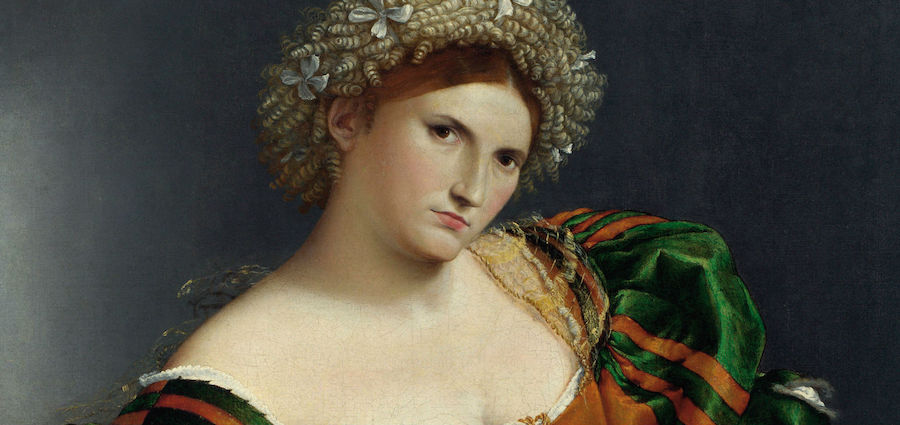
Portrait of a Woman inspired by Lucretia (1530 - 1533). Oil on canvas, 96.5 x 110.6 cm. The National Gallery, London
Let me start by highlighting what makes the 'Lorenzo Lotto. Portraits' exhibition such an exceptional project. Firstly, because never before has this subject been featured in a monographic exhibition; secondly, because this is the first ever time an exhibition of the great Venetian artist's work has been organised in Spain, which has only one of his paintings on display, here at the Prado; thirdly, because it comprises almost fifty works, some of them among his best; fourthly, because, although Lotto's main focus was, as the exhibit title would suggest, the genre at which he excelled ~ portraiture, a substantial complementary space has been added to showcase his uniquely personal and beautifully rendered religious painting; and finally, for its splendid presentation and staging at the reputable hands of Jesus Moreno. And as if all that were not enough, it is also worth mentioning with regards to the venue that this inauguration coincides with two other first-rate exhibitions, namely 'Rubens. Painter of Sketches' and 'In lapide depictum. Italian painting on stone 1530-1550", constituting a trio of internationally unmatchable calibre at the Prado.
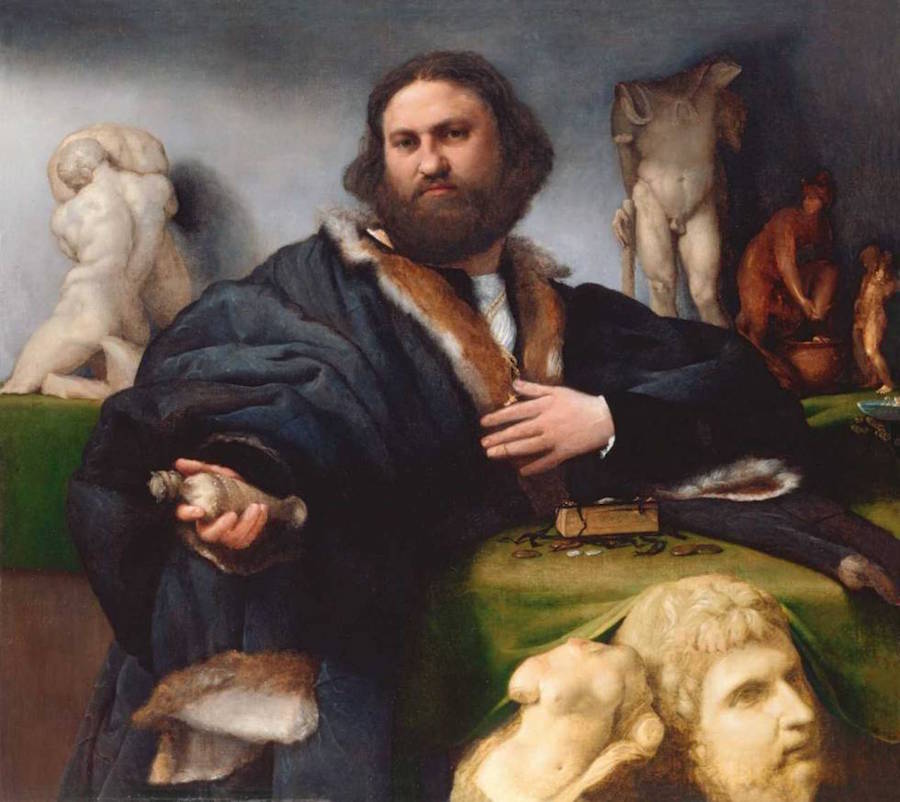
Portrait of Andrea Odoni (1527). The Royal Collection Trust, London
Moreover, Lorenzo Lotto's biography and subsequent destiny of critical acclaim are a constant source of interest. A native of Venice itself whose exact date of birth is unknown but is estimated by experts to be around 1580, our grand master's training and career start could not have been more brilliant, having as he did rolemodels such as Giovanni Bellini, of whom he was reputedly a direct disciple, along with Giorgione and Titian but he was also influenced by Antonello da Messina and Albrecht Durer, a manifestation of the great significance and variety in the configuration of his own particular style.
His early days as a professional in Venice were met with notable success and the promise of great things to come but the stiff competition with other local masters such as Titian, Tintoretto and Veronese, all of whom were endowed with a more pugnacious and business-minded temperament than his, left him with no other alternative than to seek his fortune outside the closeted enclave of the Republic's capital, in the comparatively minor cities of Veneto and neighbouring areas. In this way, Lotto managed to make ends meet with varying degrees of success and, as can often happen in the course of anyone's life, with the passage of time his star waned, only for him to end up as an oblate in Loreto, not knowing where else to live out his last days.
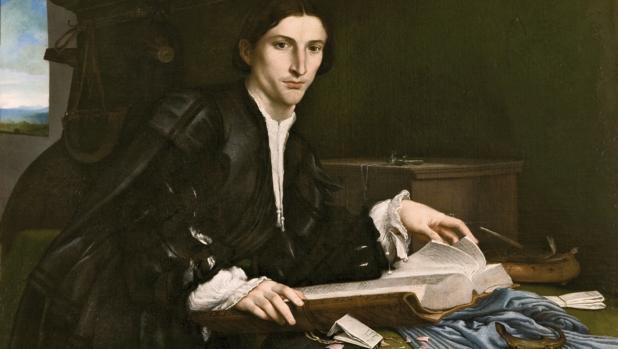
Portrait of a Young Man (1530 - 1532). Oil on canvas, 98 x 111 cm. Gallerie dell'Accademia, Venice
Then and now, the reality is that very few artists are able to make a living from their work alone and fewer still if we look back at the past because, until recently, neither were there many other options if luck wasn't on your side. In this sense, Lotto's own personal frustrations cannot be taken as exceptional and neither can the fact that at the time of his death he had not received the recognition he deserved. In actual fact, recognition of his memory and work had to wait until the 20th century when Berenson revised and raised the profile of the hitherto disdained painting of 15th century Italy but, ultimately, he didn't receive proper public acclaim until the latter stages of the 1900s. And in some ways, this widespread recognition of his oeuvre is very recent indeed, as demonstrated by this exhibition which, as previously mentioned, is only the first ever in Spain as well as being the first in the world to monographically showcase his portraiture, a genre to which Lotto made outstanding contributions. These are evidenced in the only painting of his owned by the Prado, a novelty at the time in Italy for depicting a newly-wed couple, as can be seen in the various heraldic elements. Obliged on this occasion to use a landscape format, Lotto continued to do so with individual portraits which gave the subject much greater spacial freedom and the possibility of encompassing a wider horizon. In any case, what is so extraordinary about the quality of Lotto's portraits is not limited just to their format. There is also an effect on composition, psychological aspects, his astute judgement as to the symbolic use of circumstantial details to identify the personality, rank and office of the sitter, the beautiful way he paints hands, among many others. Whatever the case, the result is that Lotto's portraits seem so modern that their impact is perhaps greater now than when they were painted because they give us the impression that their physiognomies and expressions are the same as ours. Whilst true that during the first half of the 16th century, at the height of Mannerism, this type of painting that we are so fond of today proliferated, and notwithstanding other brilliant portraitists of the time, Lotto stands out. There are a selection of his best and most well-known here at the exhibition, for instance Portrait of a Young man with a Lamp (c. 1506), Andrea Odoni (1527), Portrait of a Woman inspired by Lucretia (c. 1530-33) and Portrait of a Young Man (c. 1530-32) but there are also others of equally high quality albeit not as popular as the aforementioned, from the very early Portrait of a Young Man (c. 1498-1500), still heavily influenced by Bellini but with eyes and mouth that show a profound psychological insight, up to and including Bishop Bernardo de Rossi (1505), Portrait of a Young Man (c.1512-13), Lucina Brembati (1520-23), Portrait of a Young Man with a Book (c.1525), Portrait of a Gentleman (1535?), Portrait of a Man with a Beard (c. 1540), Portrait of a Man with a Felt Hat (h. 1541) or Portrait of an Architect (c.1540-42), to mention but a few of many outstanding pieces.
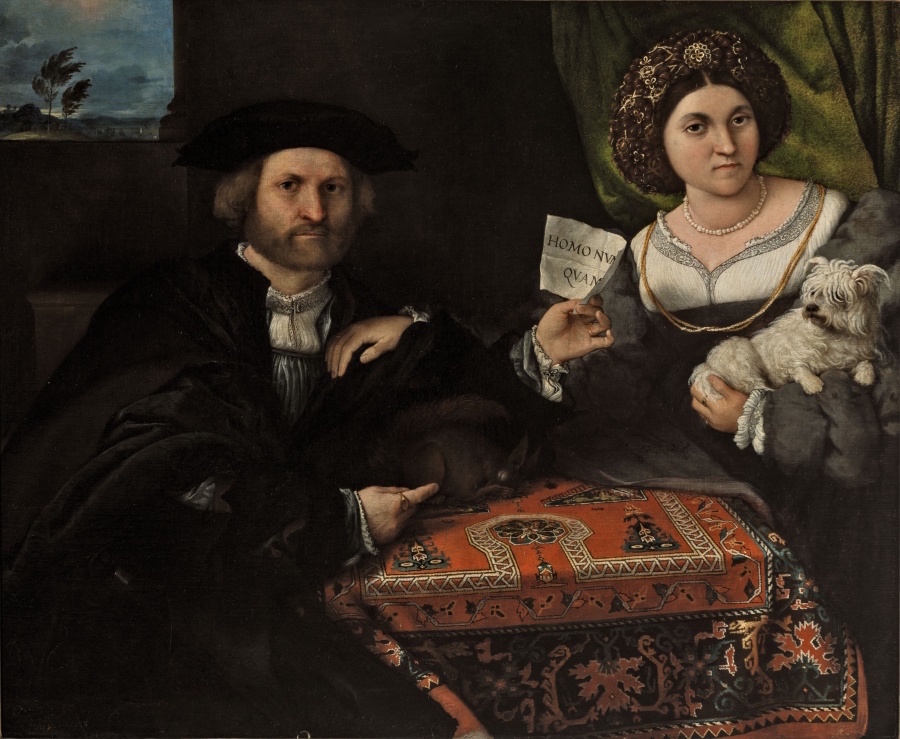
Portrait of a Married Couple (1523 - 1524). Oil on canvas, 96 x 116 cm. The State Hermitage Museum, St Petersburg
But in addition to this magnificent display of portraits, the exhibition also includes other genres in Lotto's repertoire and, in particular, his religious painting where delicate, stylised figures writhe in space as in a harmonious ballet, their body language dramatized in studiously-arranged twists and turns and the scene as a whole is wrapped in a chromatic sheen of glossy satin where colours contrast with each other in original and imaginative ways. This added bonus is an essential complement in a country like ours where the work of this Venetian painter is only being exhibited monographically for the very first time.
Lastly, and in another contribution to the ensemble, there are display cases containing various textile and gold or silver objects that don't just illustrate the dress and jewelery of those memorialised in the portraits but also explain their function within the narrative, thereby demonstrating that we are not just viewing a presentation of Lotto's paintings, but rather we are seeing an interpretation of them, and in many cases a novel one at that. It is interesting that, in this regard, the focus is on portraits where the subject is represented as an incarnation of the ideal of holiness, a burning issue at the precise moment in history when the ideological battle to control and censor images was at its peak.
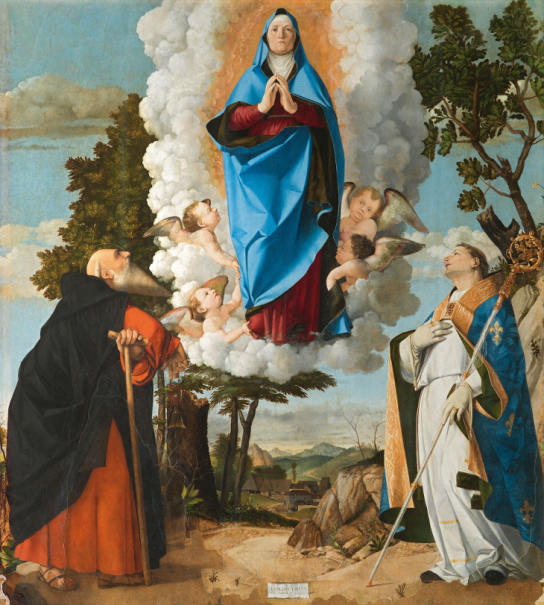
The Assumption of the Virgin with Saints Anthony Abbot and Louis of Toulouse (1506). Oil on panel, 175 x 165 cm. Cathedral of Santa Maria Assunta, Asolo
This exhibition, which after its run at the Prado will move on to the National Gallery in London, has been curated by Enrico Maria dal Pozzolo y Miguel Falomir, in collaboration with Mathias Wivel. All of them deserve to be congratulated on their splendid work, along with the layout and arrangement of the pieces, not forgetting the beautiful and informative catalogue which, in this case, is an indispensable complement to the exhibition.
(Translated from the Spanish by Shauna Devlin)
- The wonderful rediscovery of Lorenzo Lotto - - Alejandra de Argos -



